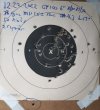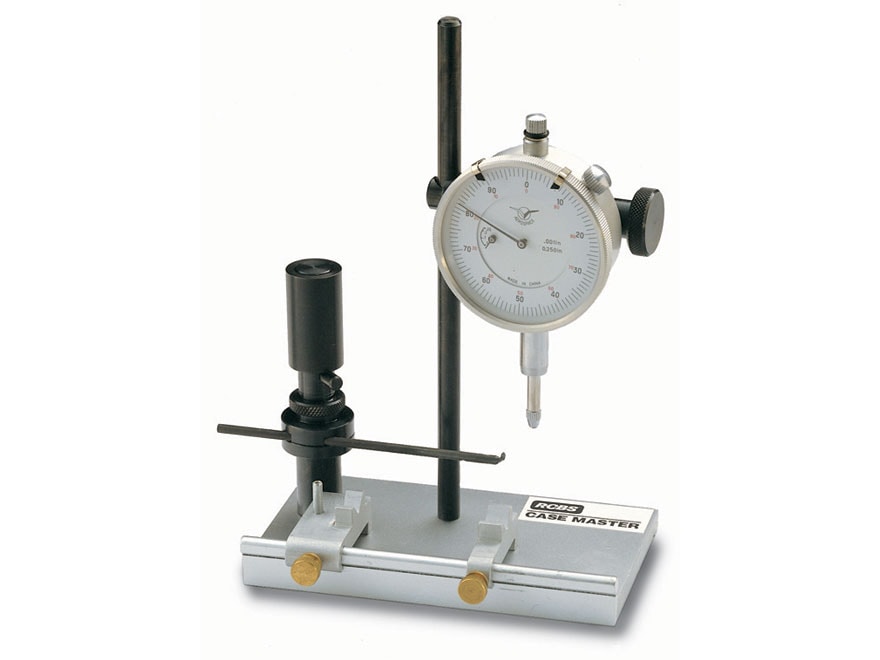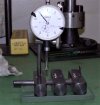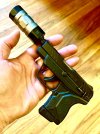To bring the .32-40 saga to a close, today was work thru the problems in search for a solution or solutions.
Made the M-die first. Body machined to 0.318 inches which is the ID of the neck to provide 0.003" of neck tension on the 0.321" bullet. ran a case thru the die and then seated a bullet. Still crooked. So, something else is going on.
The nose punch on the Lee did not look right to me. The punch was about 5/16" diameter and the adjustable punch holder was 0.375". This allowed the punch to wobble all over the place. If a bullet was not hand seated dead straight in the socket created by the M-die, it could push the punch to the side, where it would stay for the seating operation and push the bullet at an angle to the case. Here is what the punch looked like in the holder.
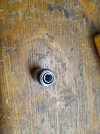
So, took a piece of 3/8 steel bar stock and made a new nose punch. Another thing I noticed about the Lee punch was the cone was small and contacted the bullet at the end of the nose. This made for a bigger moment arm to push the bullet harder to the side during seating if crooked. After several tries at various angles, I settled on a 5 deg angle for a 10 deg cone. This put more surface area on the nose and moved it much closer to the top land of the bullet. Here's the new punch in the holder. The fit was so good that I had to drill a hole thru the punch or the compressed air would push it back out of the holder.
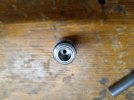
With that done, I seated another bullet. This one indicated about 0.003' runout. I was happy. I then seated another since one good'un does not mean success. That one indicated about 0.010 runout. Hmmmm... Made 2 more cartridges and the runout was somewhere between 0.006" and 0.010".
Craig, another .32-40 shooter at Wilton called me about then because he was very curious about that I was finding. He has the same Miroku .32-40 High Wall as Steve and it is tack driver. I was just starting to look harder at those cartridges to see what else might be awry. It was then that I noticed that the runout was only on one side. That made no sense. I had noticed that the new nose punch was only touching the bullet at 90 deg to the mold seam and not for 360 deg. Looking more closely when I turned the bullet in the concentricity gauge, It had the greatest runout at 90 deg to the seams, but only on ONE SIDE.
Now, I had noticed that some of his bullets had flash at the nose. That means the mold was not fully closed or warped. I concluded that I was making as straight a cartridge as possible with a tapered bullet and the rest was a mold problem.
Went to Steve's place and reviewed all the findings, showed him the new M-die and how it worked. I had full-length resized his Win cases after pulling the bullets I'd seated before I left home. Now I would run the cases thru the dies using his Bair press to see how they would come out.
But before doing that, I asked to see his mold. It is a brand new Saeco, 2-cavity. First thing I noticed was the sprue plate was so tight I could barely move it. There was also a glob of smeared lead on the top of one block half and more on the mating surface of the sprue plate. Flat-filed the lead off both pieces. While I had the sprue plate off, I examined the mating surfaces of the blocks. Nothing jumped out. Took a flat file and gently ran it over the mating surfaces. It revealed some minor bits of lead and some tiny high spots. Removed all of them and then closed the mold while watching with a bright light behind it. It closed, but the back end, nearest the hinge still showed light. I squeezed a bit and it closed. I repeated this over and over and same each time. I removed one block from the handles for more room to work. Took a fine cut round file (looked like a chain-saw file as it was Steve's) and gently ran it thru the pin holes. It dragged ever so slightly. Carefully ran it thru and removed what appeared to be a very small burr on the back pin hole. I cleaned up both pin holes and put the halves together with my hands. They closed up perfectly and easily. Put the block half back on the handle and closed the while looking for light. No light, no need to squeeze... FIXED. Put the sprue plate back on and adjusted and mold was done.
With that done, on to Steve's press to make some test rounds. First one was gorgeous. Maybe 0.003" of runout at the nose. Next one was not as good. Maybe about 0.010" runout. But that was what I was seeing with his oval bullet. Did a check and same thing. But, I did find some round bullets at his place and they made some nice cartridges with about 0.003 runout.
Now, I had found play in his press yesterday. So, I marked a case with a line and seated another bullet. Based upon the wear, the high point of the runout should be opposite the line on the case. It was. So, the press is introducing some runout by having the case tipped forward due to the column wear.
He tried the cartridges I made in his rifle. He tried 3 and 2 went in no problem. 3rd took a lot more effort. He kept them separated and told me which was which. The hard one showed much deeper engraving in the top two lands of the bullet. The other two were engraved in the same lands but not as deeply. Looking at the hard one closer, it was only engraved on one side. The bullet was oblong on that one side. Everything made sense.
So, we discussed flipping the two columns on his press 180 deg because in the down position, the shell holder carrier is rock solid. We cannot tell if the columns are the same on each end. Have to pull the press off the bench to do that and that will take a bit given the cramped quarters of his loading area. But we made major improvements in his ammo today. So, he's going to load up a bunch and we will test them next Wed at Wilton.



